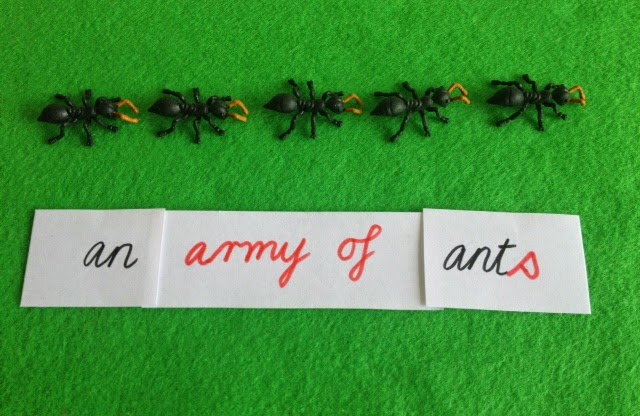Spelling words should definitely be student driven, and many of my colleagues like to balance a selection of student driven words with words that are immediately meaningful to them - words from their prepared environment.
This integration of language and all of the other learning areas is a fundamental aspect of the cosmic curriculum at work. No learning area is in isolation of another, they are all connected, and language is the key to all learning.
I have created some cards with vocabulary words from the various learning areas to incorporate into the classroom. They could be printed onto coloured card, but I prefer plain white for spelling. Although they are grouped by learning area, I am taking a selection of words from each area based on what various children in the class are working on and placing them on the shelf (I have a box earmarked to house them in but I am also considering a clear canister for this purpose as well). Alternatively they could all be put in a large jar, like fishbowl words, for children to choose freely.
A fun activity, especially as a start of the year team building exercise, is to take a selection of words that would be good to act out, place them in a jar or box and invite the children to play charades.
These lists are primarily targeted for upper elementary, but lower elementary children may also benefit from incorporating these words into their spelling repertoire. I think the children also benefit from this as it may act as a form of revision and can lead to discussion and spark a re-interest in some learning areas.
Please note in the biology set that both protista and protoctista appear - please choose according to which your class follows.
Language list, Math list, Geometry list, Biology list, History list and Geography list
What do you do in your elementary learning environment to enrich spelling and vocabulary?
Collective Nouns
Sometime after discussing concrete and abstract nouns, and possibly even after discussing masculine and feminine nouns, the child can be introduced to collective nouns.
Invite the child to identify an object (have something prepared that you have several of) and briefly revise nouns and how everything has a name.
Then introduce the collection of items.
Some children may want to keep going with this work as they may enjoy matching the collective noun with the noun.
You can find my collective noun cards HERE and in list form HERE. You could use the list as the control of error (alternatively you can write the animal type on the reverse side of the animal card before laminating).
I think it is also important, either in the same lesson or in a follow up, to illustrate that collective nouns are not limited to animals (although they are often the more interesting examples). There are fleets of ships, bouquets of flowers, bunches of bananas and so forth. The children often have a lot of fun exploring the language of collective nouns and many will want to research more examples.
You may also be interested in THIS POST
Invite the child to identify an object (have something prepared that you have several of) and briefly revise nouns and how everything has a name.
Then introduce the collection of items.
Some children may want to keep going with this work as they may enjoy matching the collective noun with the noun.
You can find my collective noun cards HERE and in list form HERE. You could use the list as the control of error (alternatively you can write the animal type on the reverse side of the animal card before laminating).
I think it is also important, either in the same lesson or in a follow up, to illustrate that collective nouns are not limited to animals (although they are often the more interesting examples). There are fleets of ships, bouquets of flowers, bunches of bananas and so forth. The children often have a lot of fun exploring the language of collective nouns and many will want to research more examples.
You may also be interested in THIS POST
Subscribe to:
Comments (Atom)









